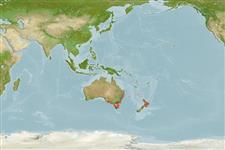Environment: milieu / climate zone / depth range / distribution range
Ecologie
marien; brak water benthopelagisch; diepte 0 - 20 m (Ref. 9002). Temperate; 25°S - 43°S, 135°E - 180°E
Western Pacific: southeastern Australia (southern Queensland to South Australia) and New Zealand.
Lengte bij maturiteit / Grootte / Gewicht / Leeftijd
Maturity: Lm 29.5, range 22 - ? cm
Max length : 71.0 cm FL mannelijk / geslacht onbekend; (Ref. 6390); common length : 35.0 cm TL mannelijk / geslacht onbekend; (Ref. 2158); max. gepubliceerd gewicht: 4.0 kg (Ref. 6390); max. gerapporteerde leeftijd: 24 Jaren (Ref. 95598)
Adults favor estuarine (including mangroves), rocky reef and inshore, coastal water habitats (Ref. 5962, 27248). They flourish in seagrass areas (Ref. 6390). Ludericks are moderately sedentary, schooling fish. They are herbivorous and feed primarily on seagrasses (Ref. 6390). Filamentous algae (Ref. 26966) and cabbage weed also form part of their diet (Ref. 28607). Marketed as fresh fish (Ref. 10384).
Maturing luderick form large aggregations. Mature fish undertake 'runs' from inside the rivers and coastal lakes to the sea. The fish spawn in the surf zone and estuary mouths (Ref. 6390).
Kailola, P.J., M.J. Williams, P.C. Stewart, R.E. Reichelt, A. McNee and C. Grieve, 1993. Australian fisheries resources. Bureau of Resource Sciences, Canberra, Australia. 422 p. (Ref. 6390)
Status op de Rode Lijst van het IUCN (Ref. 130435)
Gevaar voor de mens
Harmless
Gebruik door de mens
Visserij: commercieel; sportvis: ja
Meer informatie
ReferentiesAquacultuurAquacultuurprofielKweeklijnenGeneticaElectrophoresesErfelijkheidZiektesVerwerkingNutrientsMassaconversie
Tools
Speciale rapporten
Download XML
Internetbronnen
Estimates based on models
Preferred temperature (Ref.
123201): 14.6 - 23.6, mean 16.6 °C (based on 229 cells).
Fylogenetische diversiteitsindex (Ref.
82804): PD
50 = 0.5000 [Uniqueness, from 0.5 = low to 2.0 = high].
Bayesian length-weight: a=0.01047 (0.00626 - 0.01752), b=3.03 (2.88 - 3.18), in cm total length, based on LWR estimates for this species & (Sub)family-body (Ref.
93245).
Trofisch niveau (Ref.
69278): 2.1 ±0.1 se; based on diet studies.
Weerstandsvermogen (Ref.
120179): laag, minimale populatieverdubbelingstijd 4,5-14 jaar (K=0.2; Fec=300,000; tmax=24).
Prior r = 0.25, 95% CL = 0.14 - 0.47, Based on 1 stock assessment.
Fishing Vulnerability (Ref.
59153): Moderate vulnerability (36 of 100).
Climate Vulnerability (Ref.
125649): Very high vulnerability (81 of 100).
Nutrients (Ref.
124155): Calcium = 26.6 [13.6, 47.1] mg/100g; Iron = 0.295 [0.151, 0.530] mg/100g; Protein = 17.6 [16.4, 18.8] %; Omega3 = 0.334 [0.164, 0.724] g/100g; Selenium = 13.4 [5.4, 31.7] μg/100g; VitaminA = 6.94 [1.71, 26.86] μg/100g; Zinc = 0.729 [0.487, 1.182] mg/100g (wet weight);
